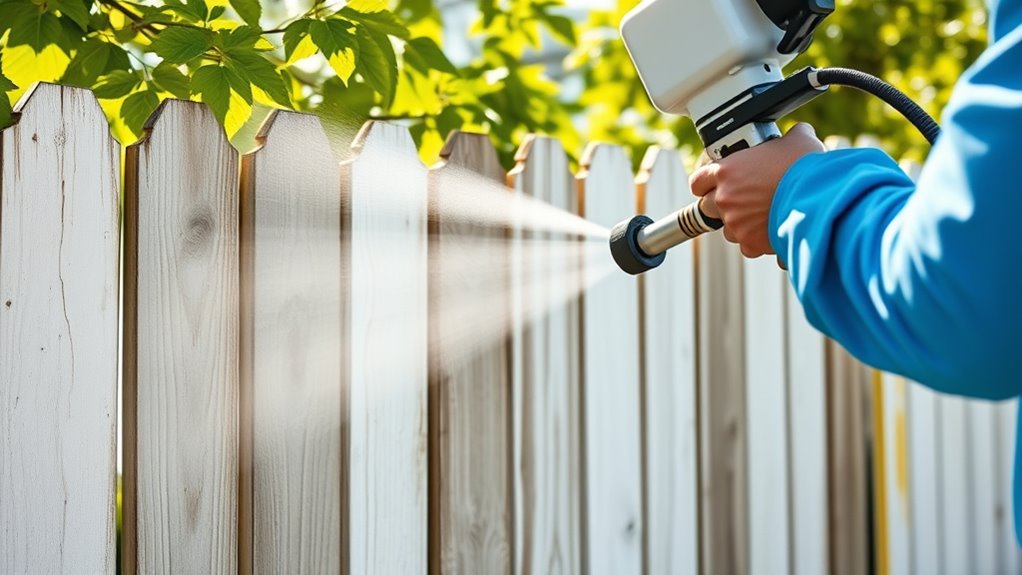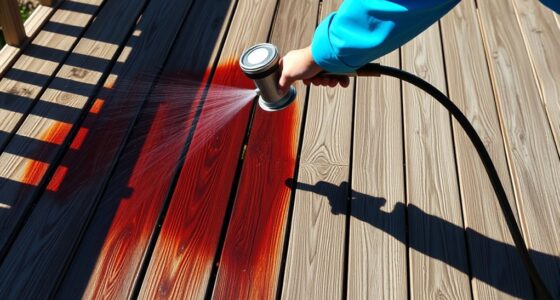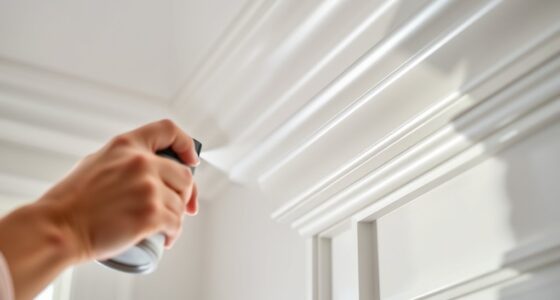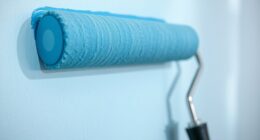To DIY fence paint with a sprayer, start by thoroughly cleaning and drying your fence, then select the right sprayer and high-quality weather-resistant paint. Apply the paint using smooth, long strokes, maintaining consistent distance, and avoid overloading to prevent drips. For a flawless finish, use light coats and proper technique. Afterward, clean your sprayer thoroughly and store it properly. Keep following these steps, and you’ll discover how to achieve a professional look with ease.
Key Takeaways
- Thoroughly clean and dry your fence, removing debris and inspecting for damage before painting.
- Choose the appropriate sprayer with adjustable settings and the right exterior paint for durability.
- Apply paint using long, even strokes with consistent overlap, maintaining steady distance from the surface.
- Use light coats, allow drying time between layers, and watch for drips or uneven coverage.
- Clean and store your sprayer properly after finishing to ensure longevity and optimal performance.
Preparing Your Fence and Workspace

Before you begin painting, it’s vital to prepare both your fence and workspace. Start with fence cleaning to remove dirt, mildew, or loose paint, making sure the new coat adheres properly. Use a power washer or scrub with a stiff brush and deck cleaner, then let it dry completely. Weather considerations are essential; avoid painting in extreme heat, cold, or when rain is forecasted. Ideal conditions are mild temperatures and low humidity, which help the paint dry evenly. Clear your workspace of obstacles and cover surrounding plants or furniture to protect them from overspray. Proper preparation ensures a smooth painting process and a long-lasting finish. Additionally, inspecting your fence for any damage or loose boards before painting helps maintain structural integrity. Taking these steps now prevents issues later and guarantees your fence looks great for years to come. Being aware of paint application techniques can further improve your results and efficiency during the project, especially considering that practical support like digital literacy programs can help seniors learn new skills for such DIY projects.
Selecting the Right Sprayer and Paint

Choosing the right sprayer and paint is essential for achieving a smooth, professional-looking finish on your fence. The sprayer nozzle size affects spray pattern and coverage, so pick one suited for wood surfaces. Confirm your paint has the right consistency—thick enough to coat well but thin enough to spray evenly. Consider a sprayer with adjustable settings for control and versatility. Compatibility with different nozzle sizes can save you time and effort. Use high-quality exterior paint designed for wood to resist weathering. Also, choose a sprayer that’s easy to clean, reducing downtime between coats. Proper airflow control features like adjustable fan patterns can improve application precision. Additionally, selecting a suitable air compressor can ensure consistent pressure and spray quality throughout your project. Finally, check for features like a wide spray width to cover more area efficiently. Selecting the appropriate sprayer type and accessories can significantly impact your project’s success. Proper tuning techniques for your equipment can optimize performance and ensure a flawless finish. With the right tools, your fence will look fantastic and professionally finished, especially if you understand the importance of heat pump features for efficiency and durability in climate control.
Applying the Paint: Techniques and Tips

To achieve a smooth, even finish when applying paint to your fence, it’s important to use consistent techniques and take your time. Proper brush techniques help control paint flow and prevent streaks, especially in tight spaces. Confirm your paint consistency is right—neither too thick nor too runny—by stirring well before use. Use long, even strokes, overlapping slightly to avoid lap marks. Keep a steady pace and maintain a consistent distance from the surface. Additionally, choosing the right materials can significantly impact the overall finish and durability of your paint job.
Ensuring an Even Finish and Avoiding Drips
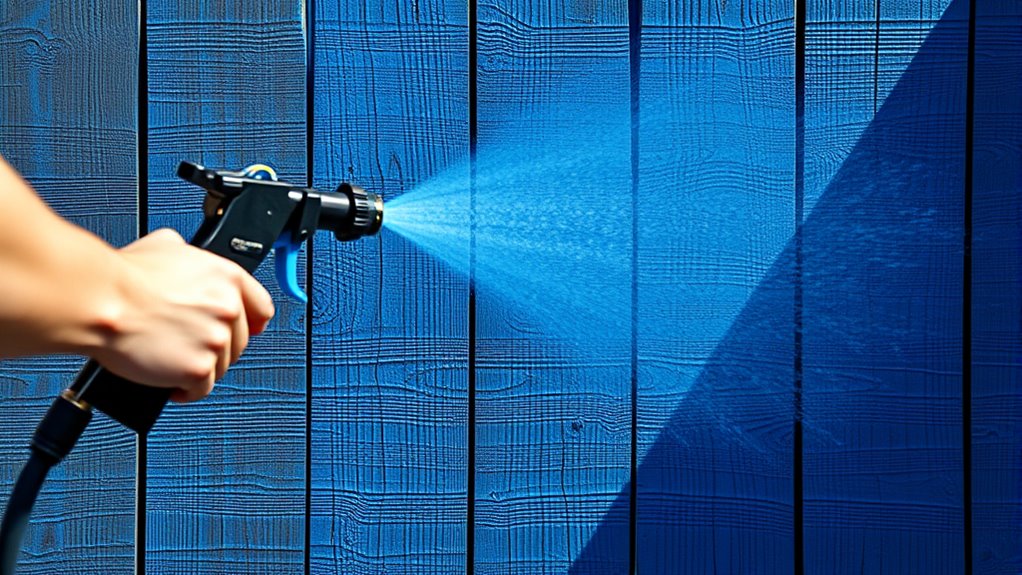
Achieving an even finish and preventing drips requires careful attention to your painting technique. To do this, focus on maintaining consistent brush techniques and ensuring the paint consistency is just right. Keep the sprayer at a steady distance from the fence, moving smoothly to avoid thick patches or streaks. Pay attention to overlapping strokes and avoid pressing too hard, which can cause drips. Regularly check your spray pattern and adjust as needed. Use light, even coats rather than heavy layers, allowing each to dry before applying the next. Proper control and patience will help you achieve a flawless finish. Additionally, understanding the science of paint application can help optimize your results. Incorporating efficient spray techniques can further improve coverage and prevent issues like uneven texture or runs. Being aware of the types of spray nozzles and adjusting them according to the project can also contribute to a more uniform finish. Using proper surface preparation methods, such as cleaning and priming the fence beforehand, can also significantly enhance the final appearance.
Cleaning Up and Maintaining Your Sprayer

After finishing your fence painting, cleaning and maintaining your sprayer is key to guaranteeing it stays in good condition for future projects. Proper sprayer maintenance involves thoroughly flushing out any remaining paint with the appropriate solvent, depending on the type of paint used. This prevents clogs and corrosion, extending the life of your equipment. Once cleaned, store your sprayer in a dry, dust-free area to protect it from damage. For paint storage, transfer leftover paint into airtight containers to prevent drying out and spoilage. Regular maintenance also includes inspecting hoses and nozzles for wear or damage. Additionally, understanding the performance metrics of your sprayer can help you identify potential issues early, ensuring optimal operation. Monitoring and adjusting thermostat settings can contribute to maintaining consistent spraying conditions and preventing unnecessary strain on your equipment. Keeping your equipment clean aligns with best practices for equipment longevity and efficient performance. Taking these steps ensures your sprayer remains in ideal working condition, ready for your next painting task without hassle or delays. Proper airflow around the unit and avoiding harsh chemicals during cleaning further contribute to equipment maintenance and durability.
Frequently Asked Questions
How Long Does Fence Paint Typically Last Before Needing a Touch-Up?
Fence paint typically lasts about 3 to 5 years before needing a touch-up, depending on your climate and fence maintenance. If you notice fading, peeling, or chipping, it’s time to refresh the paint to maintain your fence’s appearance and protection. Regular upkeep extends paint longevity. Keep an eye on the condition of your fence, and touch up areas as needed to prevent damage and preserve its look.
Can I Paint Over Old, Weathered Fence Paint Successfully?
You can definitely paint over old, weathered fence paint, but proper fence prep is key. First, clean the surface thoroughly to remove dirt and peeling paint. Sand rough areas to improve paint adhesion. Using a high-quality primer enhances paint durability and prevents peeling. With the right prep, your new coat will stick well, last longer, and give your fence a fresh, vibrant look. Proper preparation guarantees success and extends the life of your paint job.
What Safety Precautions Should I Take When Using a Sprayer?
When using a sprayer, you should prioritize safety. Wear protective gear like gloves, goggles, and a mask to guard against fumes and overspray. Make certain of good ventilation in your work area to avoid inhaling harmful particles. Keep the workspace clear of obstacles, and follow the sprayer manufacturer’s instructions. Taking these precautions helps you stay safe while achieving a professional-looking finish on your fence.
Is It Better to Paint on Windy Days or in Humid Conditions?
You might think painting on windy days is fine, but it’s actually best to avoid them. Wind can cause overspray and uneven coverage, making your project messier. Humid conditions aren’t ideal either, as they slow drying and can cause paint to drip or bubble. For the best results, choose a calm, dry day with low humidity. This way, your fence gets an even, professional finish.
How Do I Prevent Overspray From Damaging Surrounding Plants or Surfaces?
To prevent overspray from damaging surrounding plants or surfaces, you should use protective gear like masks and cover nearby areas with drop cloths or plastic sheeting. Adjust your sprayer settings to a lower pressure for better control and less mist. Keep a steady hand, and spray in a controlled, even motion. Regularly check your surroundings to guarantee overspray isn’t reaching unintended areas, protecting your landscape effectively.
Conclusion
With the right preparation and tools, DIY fence painting with a sprayer becomes an achievable project. Remember, using quality paint and proper technique can prevent drips and uneven finishes, saving you time and effort. Remarkably, some experts believe that a well-maintained sprayer not only extends its lifespan but also improves paint atomization, leading to a smoother coat. Embrace patience and care, and you’ll enjoy a beautifully transformed fence that lasts for years.
A seasoned painter with over 15 years in the industry, Mike transitioned from hands-on painting projects to the digital world of paint sprayers. His extensive experience gives him a unique perspective on what users truly need when it comes to painting tools. As the Editor in Chief of Paint Sprayer Zone, Mike ensures that every piece of content not only provides value but also reflects the realities of painting — the challenges, the joys, and the intricate details.
